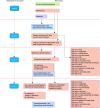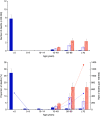Trends of mortality attributable to child and maternal undernutrition, overweight/obesity and dietary risk factors of non-communicable diseases in sub-Saharan Africa, 1990-2015: findings from the Global Burden of Disease Study 2015
- PMID: 30509334
- PMCID: PMC10260606
- DOI: 10.1017/S1368980018002975
Trends of mortality attributable to child and maternal undernutrition, overweight/obesity and dietary risk factors of non-communicable diseases in sub-Saharan Africa, 1990-2015: findings from the Global Burden of Disease Study 2015
Abstract
Objective: To assess trends of mortality attributable to child and maternal undernutrition (CMU), overweight/obesity and dietary risks of non-communicable diseases (NCD) in sub-Saharan Africa (SSA) using data from the Global Burden of Disease (GBD) Study 2015.
Design: For each risk factor, a systematic review of data was used to compute the exposure level and the effect size. A Bayesian hierarchical meta-regression analysis was used to estimate the exposure level of the risk factors by age, sex, geography and year. The burden of all-cause mortality attributable to CMU, fourteen dietary risk factors (eight diets, five nutrients and fibre intake) and overweight/obesity was estimated.
Setting: Sub-Saharan Africa.ParticipantsAll age groups and both sexes.
Results: In 2015, CMU, overweight/obesity and dietary risks of NCD accounted for 826204 (95 % uncertainty interval (UI) 737346, 923789), 266768 (95 % UI 189051, 353096) and 558578 (95 % UI 453433, 680197) deaths, respectively, representing 10·3 % (95 % UI 9·1, 11·6 %), 3·3 % (95 % UI 2·4, 4·4 %) and 7·0 % (95 % UI 5·8, 8·3 %) of all-cause mortality. While the age-standardized proportion of all-cause mortality accounted for by CMU decreased by 55·2 % between 1990 and 2015 in SSA, it increased by 63·3 and 17·2 % for overweight/obesity and dietary risks of NCD, respectively.
Conclusions: The increasing burden of diet- and obesity-related diseases and the reduction of mortality attributable to CMU indicate that SSA is undergoing a rapid nutritional transition. To tackle the impact in SSA, interventions and international development agendas should also target dietary risks associated with NCD and overweight/obesity.
Keywords: Child and maternal undernutrition; Dietary risks of non-communicable diseases; Double burden of malnutrition; Mortality; Overweight and/or obesity.
Figures















References
-
- Forouzanfar MH, Alexander L, Anderson HR et al.. (2015) Global, regional, and national comparative risk assessment of 79 behavioural, environmental and occupational, and metabolic risks or clusters of risks in 188 countries, 1990–2013: a systematic analysis for the Global Burden of Disease Study 2013. Lancet 386, 2287–2323. - PMC - PubMed
-
- Forouzanfar MH, Afshin A, Alexander LT et al.. (2016) Global, regional, and national comparative risk assessment of 79 behavioural, environmental and occupational, and metabolic risks or clusters of risks, 1990–2015: a systematic analysis for the Global Burden of Disease Study 2015. Lancet 388, 1659–1724. - PMC - PubMed
-
- Taniguchi K & Wang X (2003) Nutrition Intake and Economic Growth: Studies on the Cost of Hunger. Rome: FAO.
-
- Vos T, Barber RM, Bell B et al.. (2015) Global, regional, and national incidence, prevalence, and years lived with disability for 301 acute and chronic diseases and injuries in 188 countries, 1990–2013: a systematic analysis for the Global Burden of Disease Study 2013. Lancet 386, 743–800. - PMC - PubMed
-
- Kengne AP, Echouffo-Tcheugui J-B, Sobngwi E et al.. (2013) New insights on diabetes mellitus and obesity in Africa – Part 1: prevalence, pathogenesis and comorbidities. Heart 99, 979–983. - PubMed
Publication types
MeSH terms
LinkOut - more resources
Full Text Sources
Medical
Research Materials

